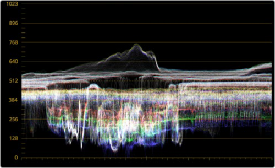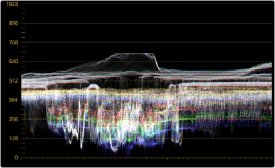< Previous | Contents | Next >
Many display manufacturers who have no interest in licensing Dolby Vision for inclusion in their displays are instead going with the simpler method of engineering their displays to be compatible with SMPTE ST.2084. It requires only a single stream for distribution, there are no licensing fees, no special hardware is required to master for it (other than an HDR mastering display), and there’s no special metadata to write or deal with.
![]()
Interestingly, SMPTE ST.2084 ratifies the “PQ” EOTF that was originally developed by Dolby, and which is used by Dolby Vision, into a general standard that accommodates encoding HDR at peak luminance values up to 10,000 cd/m2. This standard requires at minimum a 10-bit signal for distribution, and
the EOTF is mathematically described such that the video signal utilizes the available code values of a 10-bit signal as efficiently as possible, while allowing for such a wide range of luminance in the image.
SMPTE ST.2084 is also part of the “Ultra HD Premium” industry specification, which stipulates that televisions bearing the Ultra HD Premium logo have the following capabilities:
— A minimum UHD resolution of 3840 x 2160
— A minimum gamut of 90% of P3
— A minimum dynamic range of either 0.05 nits black to 1000 nits peak luminance (to accommodate LCD displays), or 0.0005 nits black to 540 nits peak luminance (to accommodate OLED displays)
— Compatibility with SMPTE ST.2084
Finally, ST.2084 has been included in the HDR 10 standard adopted by the Blu-ray Disc Association (BDA) that covers Ultra HD Blu-ray. HDR 10 stipulates that Ultra HD Blu-ray discs have the following characteristics:
— UHD resolution of 3840 x 2160
— Up to the Rec. 2020 gamut
— SMPTE ST.2084
— Mastered with a peak luminance of 1000 nits
The downside is that, by itself, an HDR10 mastered program is not backward compatible with BT.709 displays using BT.1886 (although the emerging HDR10+ standard described later addresses this).
Furthermore, no provision is made to scale the above-100 nit portion of the image to accommodate different displays with differing peak luminance levels. For example, if you grade and master an image to have peak luminance of 4000 nits, and you play that signal on an HDR10-compatible television (using ST.2084) that’s only capable of 800 nits, then everything above 800 nits will be clipped, while everything below 800 nits will look exactly as it should relative to your grade.
This is because ST.2084 is referenced to absolute luminance. If you grade an HDR image referencing a 1000 nit peak luminance display, as is recommended by HDR10, then any display using ST.2084
will respect and reproduce all levels from the HDR signal that it’s capable of reproducing as you graded them, up to the maximum peak luminance level it can reproduce. For example, on an HDR10- compatible television capable of outputting 500 nits, all mastered levels from 501–1000 will be clipped, as seen in the screenshot below.


![]()